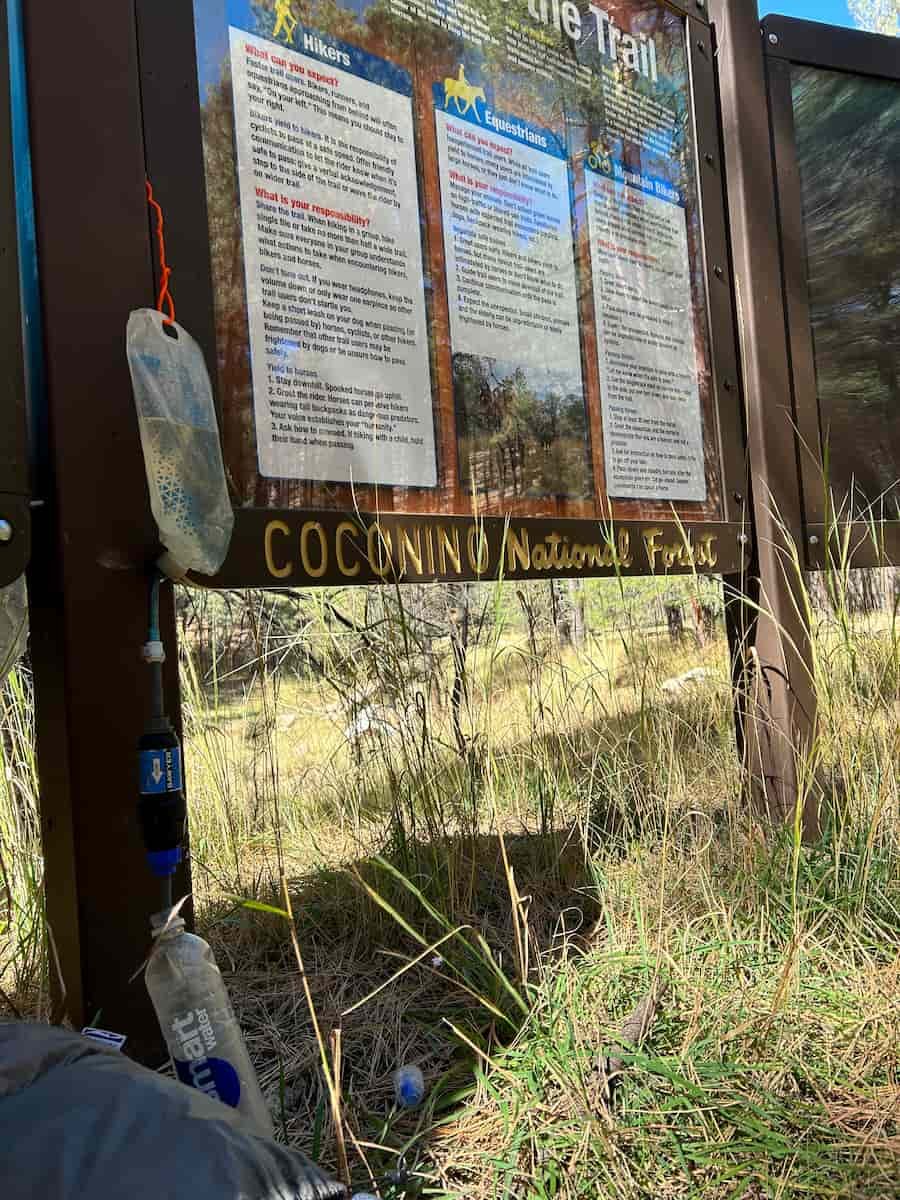Liz's Favorite Gear From the Arizona Trail
the surprising gear that made a difference over 800 miles of backpacking
December 7th, 2023
Liz is back from an 800-mile thru-hike of the Arizona Trail. Before Liz left, she consulted Naomi's AZT thru-hiking advice for some gear tips. As a result, she changed around her usual gear staples for items tailored for the unique and challenging terrain on the AZT.
Here are a few of her favorite gear items for thru-hiking the Arizona Trail.
Liz used the Nite Ize Gear Ties to turn her Sawyer Squeeze into a gravity filter. The Gear Ties allowed her to suspend her dirty water bag from all sorts of awkward angled services, including this trail kiosk sign.
The humble gear tie was one of the MVPs of the Arizona Trail. The AZT doesn't have a ton of water sources and it feels like thru-hikers spend hours filtering water. "Squeezing water is the worst part of my day," one thru-hiker told me. Enter: the gear tie.
This sub-$5 tool turned my Sawyer Squeeze filter into a gravity system. The way I see it, I'm going to stop walking to eat anyway, so may as well turn gravity into my friend and have it do the water filter work.
I tied my gear ties to trees, bushes, and even signs. Naomi even figured out how to create a tripod with trekking poles to suspend her gravity filter.
The Gear Ties can hold a surprising amount of weight suspended at weird angles–giving more options for hanging than a mini-carabiner. It's available in bright orange and yellow, too, so it's harder to lose.
Liz hiked the Arizona Trail in the Altra Olympus, a cushy alternative to the thru-hiker favorite Altra Lone Peak. That extra cushioning was valuable on the rocky terrain of the AZT.
Altra Olympus
Naomi warned me that the AZT is a rocky trail and can tear up even the most trail-strong feet. She even wrote in her guide on insoles about how third-party footbeds are helpful on a trail this rough.
I didn't take any chances and decided from the get-go to start the trail with a burlier shoe than my usual trail running shoe. I've hiked nearly every thru-hike over the last 10 years in Altra Lone Peak. But for the AZT, I upgraded to their max cushion trail runner: the Altra Olympus (men's and women's).
I wore an older pair of Olympus I found in my closet (got it on sale and squirreled it away) for the first half of the trail and switched out to the new Olympus 5 for the latter half.
Despite plenty of 30+ mile days on rocky terrain, there wasn't a single day I didn't thank myself for opting for the Olympus instead of the Lone Peak. The max cushion made a difference on days where the trail was indistinguishable from a pile of rocks.
I enjoyed the sturdy, wide platform of the Olympus so much that now that I'm done with the AZT, I've taken it out on steep and loose day hikes. I must admit, I'm dreading the day this pair is spent and I will have to go back to the old pair of Lone Peaks in my closet.
MEN'S
WOMEN'S
Liz used the Neo Air XTherm NXT sleeping pad on the Arizona Trail, which has extra insulation for cold nights.
Neo Air Xtherm NXT
Hear me out–a super insulated inflatable sleeping pad sounds like a disaster on a desert trail. The fact that my NeoAir XTherm NXT survived 800-miles of spiky plants and kept me warm on sub-freezing nights is enough evidence to me that it deserves its title as a favorite gear piece for the AZT.
A southbound AZT hike can get cold, especially on the north rim of the Grand Canyon. But because I also knew parts of the AZT would get hot, I opted for a very lightweight sleeping quilt (the Katabatic Palisade 30) instead of my 20F degree sleeping bag. The XTherm allowed me to stretch my sleeping system into cooler temperatures without feeling cold. Plus, the fabric on the Xtherm feels thicker than the XLite, which made me think it was more durable around the spiky plants of the desert.
I met one other hiker who was carrying an XTherm on the AZT and we both high-fived over our excellent decision, even if others gave us weird looks. Desert nights can be 40F or more cooler than daytime temperatures–and I find the extreme changes are hard on my body. The warmth radiating up from my Xtherm each night lulled me to sleep on long nights.
Southbounders don't get a ton of daylight and staying comfy during those 8-12 hours in bed is important, too. At a 2 oz penalty over the NeoAir XLite NXT or a regular length foam pad, this was an easy decision.










